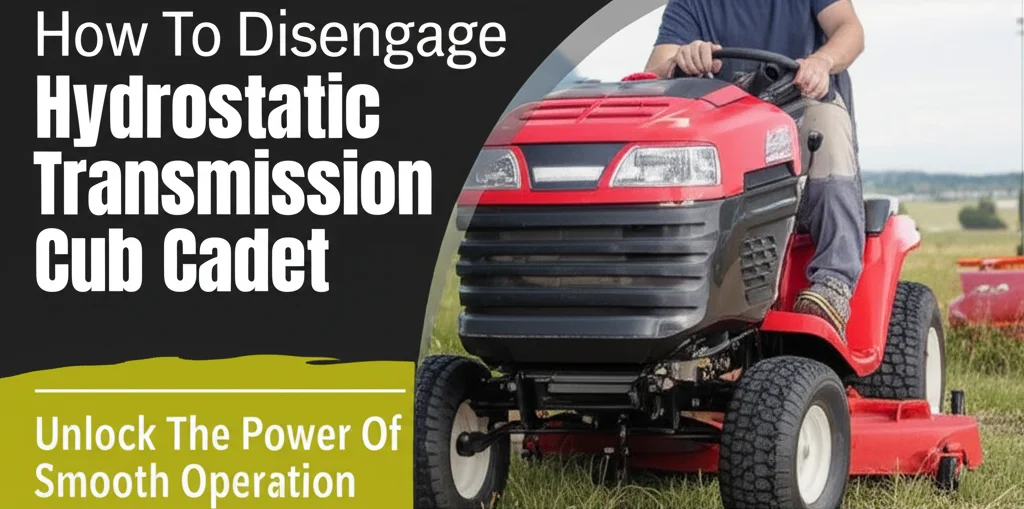· Lawn Mower Maintenance · 8 min read
Cub Cadet Tank Problems

Cub Cadet Tank Problems: A Comprehensive Guide
Is your Cub Cadet mower giving you trouble? Often, the source of the problem isn’t a complex engine issue, but something simpler – problems with the fuel tank. A malfunctioning fuel tank can lead to a variety of performance issues, from starting difficulties to reduced power. This article will walk you through the most common Cub Cadet tank problems, how to identify them, and what you can do to get your mower running smoothly again. We’ll cover everything from fuel leaks to contamination, ensuring you have the knowledge to tackle these issues head-on.
Takeaway:
- Regularly inspect your Cub Cadet’s fuel tank for cracks or leaks.
- Use fuel stabilizer to prevent sediment buildup and corrosion.
- Replace the fuel filter annually to maintain optimal fuel flow.
- Properly store your mower during the off-season to minimize fuel-related issues.
Quick Answer: Cub Cadet tank problems typically involve fuel leaks, sediment buildup, or a faulty fuel cap. These issues can cause starting problems, reduced engine power, and even complete engine failure. Regular maintenance and proper fuel storage are key to preventing these issues.
1. Fuel Leaks: Identifying and Repairing Tank Damage
Finding a fuel leak on your Cub Cadet is a serious concern. Fuel leaks aren’t just messy; they’re a fire hazard. The first step is to carefully inspect the fuel tank itself for any visible cracks or holes. Pay close attention to seams, welds, and areas around fittings. If you spot a leak, don’t attempt to operate the mower.
Common Leak Locations
- Tank Seams: Over time, the seams of the fuel tank can weaken and develop cracks.
- Fuel Cap: A damaged or improperly sealed fuel cap can allow fuel to escape, especially during operation.
- Fuel Line Connections: Check the connections where the fuel lines attach to the tank for tightness and signs of leakage.
- Vent Hole: The fuel tank has a vent hole to allow air in as fuel is used; a blockage or damage here can cause pressure buildup and leaks.
Small cracks can sometimes be repaired with a fuel tank repair kit, but significant damage usually requires replacing the entire tank. If you’re uncomfortable with this repair, consider taking your mower to a qualified service technician. For related issues, you might also want to check out this article on Cub Cadet LTX 1040 problems.
2. Sediment and Debris Buildup in the Fuel Tank
Old fuel and contaminants can accumulate at the bottom of your Cub Cadet’s fuel tank. This sediment restricts fuel flow and can clog the fuel filter and carburetor. This is especially common if the mower sits unused for extended periods. You might notice sputtering, difficulty starting, or a loss of power as a result.
Preventing Sediment Buildup
- Fuel Stabilizer: Add fuel stabilizer to the gasoline, especially before storing the mower for the off-season. This prevents the fuel from breaking down and forming gum and varnish.
- Fresh Fuel: Use fresh gasoline. Gasoline degrades over time, even with stabilizer.
- Proper Storage: Store your mower in a clean, dry environment.
To clean a fuel tank with sediment, carefully drain the old fuel. Then, you can use a fuel tank cleaner additive, following the manufacturer’s instructions. Alternatively, you can carefully remove the tank and flush it with fresh gasoline, ensuring you dispose of the dirty fuel properly. If you’re experiencing carburetor issues alongside this, consider reading about Cub Cadet zero-turn carburetor problems.
3. Faulty Fuel Cap Issues and Vapor Lock
A seemingly simple component, the fuel cap, plays a crucial role in maintaining proper fuel system pressure. A damaged or improperly sealed fuel cap can lead to fuel evaporation, vapor lock, and even fuel leaks. Vapor lock occurs when fuel vaporizes in the fuel lines, creating a blockage and preventing fuel from reaching the engine.
Symptoms of a Bad Fuel Cap
- Difficulty Starting: If the fuel cap isn’t sealing properly, the fuel system may not maintain adequate pressure for starting.
- Engine Stalling: A faulty cap can cause intermittent fuel supply, leading to engine stalling.
- Fuel Smell: A noticeable fuel odor indicates a leak around the cap.
Inspect the fuel cap’s rubber seal for cracks or damage. Replace the cap if it’s damaged or if it doesn’t seal tightly. Ensure the vent hole in the cap isn’t blocked. For more information on starting issues, check out this article on Cub Cadet zero-turn starting problems.
4. Corroded Fuel Tank: Rust and its Effects
Rust inside the fuel tank is a common problem, especially in older Cub Cadet mowers. Rust particles contaminate the fuel, causing carburetor clogs, fuel filter blockages, and engine damage. The corrosion weakens the tank itself, potentially leading to leaks.
Identifying a Corroded Tank
- Rusty Fuel: If the fuel appears rusty or contains particles, the tank is likely corroded.
- Visible Rust: Inspect the inside of the tank (if possible) for visible rust.
- Pinholes: Severe corrosion can create pinholes in the tank, leading to leaks.
Unfortunately, a severely corroded fuel tank usually needs to be replaced. You can attempt to clean a lightly rusted tank with a fuel tank cleaner and a rust converter, but this is often a temporary solution. Preventative measures, like using fuel stabilizer and storing the mower properly, are the best defense against corrosion.
5. Blocked Fuel Tank Vent: Pressure Imbalance
The fuel tank vent allows air to enter the tank as fuel is used, preventing a vacuum from forming. A blocked vent creates a pressure imbalance, hindering fuel flow and causing the engine to run poorly or stall. This is often overlooked but can cause significant issues.
Symptoms of a Blocked Vent
- Engine Stalling Under Load: The engine may run fine at idle but stall when mowing thick grass.
- Difficulty Starting: A vacuum in the tank can make it difficult to draw fuel.
- Fuel Tank Collapsing (Rare): In extreme cases, a blocked vent can cause the fuel tank to collapse.
Check the fuel tank vent for obstructions, such as dirt, debris, or insect nests. You can usually clear the vent with a small wire or compressed air. Ensure the vent hose isn’t kinked or damaged.
6. Fuel Filter Issues Related to Tank Contamination
While not directly a tank problem, a clogged fuel filter is often a result of issues originating in the fuel tank. Sediment, rust, and debris from the tank travel through the fuel lines and clog the filter, restricting fuel flow. A clogged fuel filter causes the same symptoms as other fuel system problems: difficulty starting, reduced power, and engine stalling.
Maintaining Your Fuel Filter
- Annual Replacement: Replace the fuel filter at least once a year, or more often if you use the mower frequently.
- Regular Inspection: Inspect the fuel filter periodically for signs of clogging.
- Proper Installation: Ensure the fuel filter is installed correctly, with the arrow pointing in the direction of fuel flow.
For more information on engine issues, you might find this article on Cub Cadet EFI engine problems helpful.
7. Choosing the Right Fuel for Your Cub Cadet
Using the correct fuel is crucial for preventing tank problems. Ethanol-blended gasoline can absorb water, leading to corrosion and sediment buildup. Ethanol can also damage rubber components in the fuel system.
Fuel Recommendations
- Ethanol-Free Gasoline: If possible, use ethanol-free gasoline.
- Low-Ethanol Gasoline: If ethanol-free gasoline isn’t available, use gasoline with the lowest ethanol content possible (E10 or less).
- Fuel Stabilizer: Always add fuel stabilizer to gasoline, especially before storing the mower.
Frequently Asked Questions (FAQ)
Q: How often should I replace my Cub Cadet fuel tank? A: A fuel tank should be replaced when it’s severely damaged, corroded, or leaking. With proper maintenance and fuel storage, a tank can last for many years, but expect to replace it eventually, typically after 5-10 years depending on usage and storage conditions.
Q: Can I repair a cracked Cub Cadet fuel tank myself? A: Small cracks may be repairable with a fuel tank repair kit, but it’s generally recommended to replace the tank for safety and reliability.
Q: What causes fuel to go bad in my Cub Cadet tank? A: Fuel degrades over time due to oxidation and the effects of ethanol. Exposure to air and moisture accelerates this process.
Q: How do I know if my Cub Cadet fuel filter is clogged? A: Symptoms of a clogged fuel filter include difficulty starting, reduced engine power, and engine stalling.
Q: Is it safe to use gasoline with high ethanol content in my Cub Cadet? A: High ethanol content (E15 or higher) is generally not recommended, as it can damage fuel system components and cause corrosion.
Conclusion
Addressing Cub Cadet tank problems proactively can save you time, money, and frustration. Regular inspection, proper fuel storage, and routine maintenance are key to keeping your mower running reliably. Remember to use fuel stabilizer, replace the fuel filter annually, and address any leaks or corrosion promptly. By following these tips, you can ensure your Cub Cadet continues to provide years of dependable service. Don’t hesitate to consult a qualified service technician if you’re unsure about any repair.
- Cub Cadet
- Fuel Tank
- Lawn Mower Repair
- Small Engine Problems

